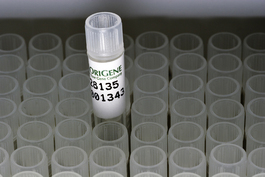PSMC5 (NM_001199163) Human Untagged Clone
CAT#: SC331256
PSMC5 (untagged) - Homo sapiens proteasome (prosome, macropain) 26S subunit, ATPase, 5 (PSMC5), transcript variant 2
"NM_001199163" in other vectors (2)
Product Images

Specifications
| Product Data | |
| Type | Human Untagged Clone |
| Tag | Tag Free |
| Symbol | PSMC5 |
| Synonyms | p45; p45/SUG; S8; SUG-1; SUG1; TBP10; TRIP1 |
| Vector | pCMV6 series |
| Sequence Data |
>NCBI ORF sequence for NM_001199163, the custom clone sequence may differ by one or more nucleotides
ATGGAGCTGGAGGAGGGGAAGGCAGGCAGCGGACTCCGCCAATATTATCTGTCCAAGATTGAAGAACTCC AGCTGATTGTGAATGATAAGAGCCAAAACCTCCGGAGGCTGCAGGCACAGAGGAACGAACTAAATGCTAA AGTTCGCCTATTGCGGGAGGAGCTACAGCTGCTGCAGGAGCAGGGCTCCTATGTGGGGGAAGTAGTCCGG GCCATGGATAAGAAGAAAGTGTTGGTCAAGGTACATCCTGAAGGTAAATTTGTTGTAGACGTGGACAAAA ACATTGACATCAATGATGTGACACCCAATTGCCGGGTGGCTCTAAGGAATGACAGCTACACTCTGCACAA GATCCTGCCCAACAAGGTAGACCCATTAGTGTCACTGATGATGGTGGAGAAAGTACCAGATTCAACTTAT GAGATGATTGGTGGACTGGACAAACAGATCAAGGAGATCAAAGAAGTGATCGAGCTGCCTGTTAAGCATC CTGAGCTCTTCGAAGCACTGGGCATTGCTCAGCCCAAGGGAGTGCTGCTGTATGGACCTCCAGGCACTGG GAAGACACTGTTGGCCCGGGCTGTGGCTCATCATACGGACTGTACCTTTATTCGTGTCTCTGGCTCTGAA CTGGTACAGAAATTCATAGGGGAAGGGGCAAGAATGGTGAGGGAGCTGTTTGTCATGGCACGGGAACATG CTCCATCTATCATCTTCATGGACGAAATCGACTCCATCGGCTCCTCGCGGCTGGAGGGGGGTTCTGGAGG GGACAGTGAAGTGCAGCGCACGATGCTGGAGTTGCTCAACCAGCTCGACGGCTTTGAGGCCACCAAGAAC ATCAAGGTTATCATGGCTACTAATAGGATTGATATCCTGGACTCGGCACTGCTTCGCCCAGGGCGCATTG ACAGAAAAATTGAATTCCCACCCCCCAATGAGGAGGCCCGGCTGGACATTTTGAAGATTCATTCTCGGAA GATGAACCTGACCCGGGGGATCAACCTGAGAAAAATTGCTGAGCTCATGCCAGGAGCATCAGGGGCTGAA GTGAAGGGCGTGTGCACAGAAGCTGGCATGTATGCCCTGCGAGAACGGCGAGTCCATGTCACTCAGGAGG ACTTTGAGATGGCAGTAGCCAAGGTCATGCAGAAGGACAGTGAGAAAAACATGTCCATCAAGAAATTATG GAAGTGA |
| Restriction Sites | SgfI-MluI |
| ACCN | NM_001199163 |
| OTI Disclaimer | Our molecular clone sequence data has been matched to the reference identifier above as a point of reference. Note that the complete sequence of our molecular clones may differ from the sequence published for this corresponding reference, e.g., by representing an alternative RNA splicing form or single nucleotide polymorphism (SNP). |
| Product Components | The cDNA clone is shipped in a 2-D bar-coded Matrix tube as dried plasmid DNA. The package also includes 100 pmols of both the corresponding 5' and 3' vector primers in separate vials. Every lot of primer is tested to provide clean sequencing of OriGene TrueClones. |
| Reconstitution | 1. Centrifuge at 5,000xg for 5min. 2. Carefully open the tube and add 100ul of sterile water to dissolve the DNA. 3. Close the tube and incubate for 10 minutes at room temperature. 4. Briefly vortex the tube and then do a quick spin (less than 5000xg) to concentrate the liquid at the bottom. 5. Store the suspended plasmid at -20°C. The DNA is stable for at least one year from date of shipping when stored at -20°C. |
| Reference Data | |
| RefSeq | NM_001199163.1, NP_001186092.1 |
| RefSeq Size | 1507 bp |
| RefSeq ORF | 1197 bp |
| Locus ID | 5705 |
| Cytogenetics | 17q23.3 |
| Protein Families | Druggable Genome |
| Protein Pathways | Proteasome |
| Gene Summary | 'The 26S proteasome is a multicatalytic proteinase complex with a highly ordered structure composed of 2 complexes, a 20S core and a 19S regulator. The 20S core is composed of 4 rings of 28 non-identical subunits; 2 rings are composed of 7 alpha subunits and 2 rings are composed of 7 beta subunits. The 19S regulator is composed of a base, which contains 6 ATPase subunits and 2 non-ATPase subunits, and a lid, which contains up to 10 non-ATPase subunits. Proteasomes are distributed throughout eukaryotic cells at a high concentration and cleave peptides in an ATP/ubiquitin-dependent process in a non-lysosomal pathway. An essential function of a modified proteasome, the immunoproteasome, is the processing of class I MHC peptides. This gene encodes one of the ATPase subunits, a member of the triple-A family of ATPases which have a chaperone-like activity. In addition to participation in proteasome functions, this subunit may participate in transcriptional regulation since it has been shown to interact with the thyroid hormone receptor and retinoid X receptor-alpha. Two transcript variants encoding different isoforms have been found for this gene. [provided by RefSeq, Nov 2010]' Transcript Variant: This variant (2) differs in the 5' UTR and coding sequence compared to variant 1. The resulting isoform (2) is shorter at the N-terminus compared to isoform 1. |
Documents
| Product Manuals |
| FAQs |
Resources
Other Versions
| SKU | Description | Size | Price |
|---|---|---|---|
| RC233976 | PSMC5 (Myc-DDK tagged) - Homo sapiens proteasome (prosome, macropain) 26S subunit, ATPase, 5 (PSMC5), transcript variant 2 |
USD 420.00 |
|
| RG233976 | PSMC5 (GFP-tagged) - Homo sapiens proteasome (prosome, macropain) 26S subunit, ATPase, 5 (PSMC5), transcript variant 2 |
USD 460.00 |
{0} Product Review(s)
Be the first one to submit a review






























































































































































































































































 Germany
Germany
 Japan
Japan
 United Kingdom
United Kingdom
 China
China
